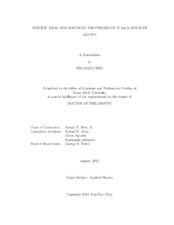| dc.description.abstract | The recent discovery of giant magnetocaloric effects (MCE) at around room temperature has triggered the possibility of the development of a magnetic refrigerator that operates at ambient temperature. One of the main characteristics of giant magnetocaloric materials is the existence of a first order magnetic phase transition coupled with variations of the lattice parameter. This causes a huge entropy change which can be utilized practically. The martensitic transformation in these materials can be driven by either sweeping the magnetic field or the temperature and this property provides the flexibility to design thermodynamic cycles. Therefore, investigation of the entropy and the cooling power generated across this martensitic transition becomes important for practical purposes. However, the details of the correlation between the martensitic transition and magneto-elastic coupling in giant MCE materials have not been completely understood.
Among new magnetocaloric materials, Ni-Mn-In Heusler alloys have attracted considerable attention as novel rare-earth free magnetic refrigerants. In order to fully understand the properties of the martensitic phase transition in Ni-Mn-In Heusler alloys and its influence on the MCE, we studied four well-characterized materials with nominal compositions Ni50Mn36In14, Ni50Mn35.5In14.5, Ni48Mn35In17 and Ni48Mn38In14, which differ in that the former two materials exhibit a paramagnetic to antiferromagnetic transition, whereas the others exhibit an additional ferromagnetic transition. We performed magnetization and field-dependent calorimetry measurements. The results provide a firm basis for the analytic evaluation of field-induced entropy changes and relative cooling power in these and related materials. We find that two of the samples (Ni50Mn36In14 and Ni50Mn35.5In14.5) include an additional entropy contribution beyond that due to magnetic spins due to the magneto-elastic coupling, which can be explained in terms of the renormalization of the phonon contributions. We also showed that the magnetization and calorimetry results give a consistent measure of antiferromagnetic plus superparamagnetic behavior of these materials to a model with Mn showing local moment behavior. The analysis provides a specific picture of the superparamagnetic properties of Ni50Mn36In14 and the spin canting behavior of Ni50Mn35.5In14.5. Further analysis of the relative cooling power provides a prediction which is shown to give a firm foundation for understanding the practical behavior of compositions with ferromagnetic and martensitic transformation nearly coinciding. | en |


